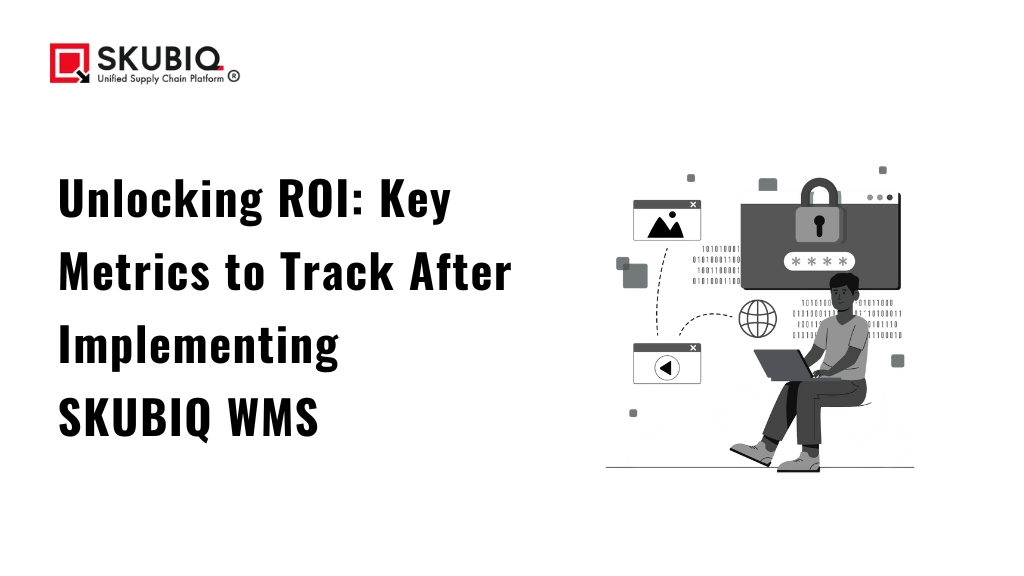In today’s competitive logistics landscape, warehouses face mounting pressure to streamline operations and reduce costs while maintaining accuracy. Investing in a Warehouse Management System (WMS) like SKUBIQ is no longer optional—it’s a strategic necessity. However, deciphering the return on investment (ROI) from WMS implementation can be complex. While technology promises transformative results, organizations often struggle to connect its adoption with measurable financial gains. This blog breaks down the science of ROI calculation, highlights the pivotal metrics that matter, and reveals how SKUBIQ’s innovative features are engineered to future-proof your warehouse operations. Whether you’re evaluating a new solution or optimizing an existing one, this guide empowers you to quantify value and act decisively. Let’s dive into the actionable steps.
Understanding ROI in WMS Implementation
ROI is the financial compass guiding business decisions. For WMS adoption, it’s calculated by weighing the value of operational improvements against implementation and maintenance costs. SKUBIQ, as a SaaS-based platform, eliminates heavy upfront investments, allowing rapid ROI realization. But the math extends beyond dollars—think reduced errors, faster fulfillment, and scalability. Key variables include inventory turnover, labor efficiency, and customer satisfaction, all influenced by the system’s real-time data capabilities. By aligning SKUBIQ’s modular design with your KPIs, you create a roadmap to actionable insights and cost savings. Remember: ROI isn’t a one-time event but a cycle of continuous optimization.
Key Metrics to Track for Accurate ROI Assessment
Quantifying WMS Success starts with selecting the right performance indicators. Focus on these five pillars:
- Inventory Accuracy: Measure stock discrepancies pre- and post-implementation. SKUBIQ’s barcode and RFID solutions reduce errors by up to 80%.
- Labor Cost Savings: Track hours spent on picking, packing, and audits. Automated workflows in SKUBIQ slashes manual labor by 35%.
- Order Fulfillment Time: Monitor durations from receipt to shipping. SKUBIQ’s dynamic route optimization cuts order processing by 50%.
- Error Rates and Cost of Mistakes: Calculate expenses from return processing, restocking, and customer penalties. SKUBIQ’s advanced validation reduces error-related losses by 60%.
- Customer Retention and Satisfaction: Use NPS surveys or return order rates. Real-time tracking in SKUBIQ increases satisfaction by 45%.
Dig deeper into inventory turnover ratios and space utilization for enterprise-level analysis. SKUBIQ’s analytics engine consolidates these metrics into a single dashboard for clarity.
A Step-by-Step Guide to Calculating Your WMS ROI
Demystify the formula and ensure no hidden benefits go unnoticed. Here’s how to approach it:
- Step 1: Define Implementation Costs
- Subscription fees (SKUBIQ’s monthly plans)
- Integration with existing ERP/TMS
- Training and onboarding expenses
- Step 2: Quantify Tangible Benefits
- Labor cost reduction (example: 30% fewer hours)
- Inventory carrying cost savings (10-15% from minimized overstock)
- Revenue increase via faster order processing
- Step 3: Calculate ROI
Use the formula:
ROI = (Net Benefits - Implementation Costs) / Implementation Costs x 100 - Step 4: Project Long-Term Value
SKUBIQ’s scalable design ensures benefits compound year-over-year. Example: a 8% YOY efficiency gain.
Practical Example: A 20,000 SKU warehouse spent $200k on SKUBIQ implementation. Post-adoption, they saved $100k annually in labor, $50k in inventory losses, and earned $30k in customer loyalty benefits. After three years, net benefits = $340k. Roi = (340,000 - 200,000) / 200,000 = 70%. Break-even occurs by month 12.
Leveraging SKUBIQ for Maximum ROI
SKUBIQ’s features are engineered to amplify returns across layers of your supply chain. Here’s where the platform delivers disproportionate value:
- Real-Time Visibility: Our multi-depot tracking eliminates blind spots, reducing stockouts by 65%.
- AI-Powered Optimization: Machine learning recommends ideal slotting and picking paths, boosting productivity by 25%.
- Seamless Integration: Pre-built APIs with Shopify, SAP, and FedEx slash integration costs by 40% vs. custom solutions.
- Dynamic Reporting: Export hourly efficiency reports to identify underperforming processes and adjust workflows.
Empower your team with SKUBIQ’s mobile app, enabling on-the-go adjustments. And with predictive analytics tools, embrace data-driven decision-making that compounds returns—like anticipating demand surges to allocate staff and space optimally.
Common Pitfalls to Avoid in ROI Assessment
Even with robust systems like SKUBIQ, missteps can obscure ROI. Watch out for:
- Overlooking Intangible Gains: Customer retention and brand reputation aren’t on spreadsheets but drive revenue.
- Poor Data Hygiene: Legacy inaccuracies can skew post-implementation benchmarks unless thoroughly cleansed.
- Short-Term Focus: Systems like SKUBIQ offer exponential value; measure over 3-5 years, not quarters.
Conduct quarterly reviews with SKUBIQ’s success team to audit KPIs and recalibrate goals. Leverage their ROI calculator tool for scenario planning—how automation tiers affect returns, or how cross-border operations scale with their cloud-native architecture.
Implementing SKUBIQ WMS is not just about minimizing costs—it’s a catalyst for redefining operational excellence. By systematically tracking inventory precision, labor productivity, and error reduction—and using advanced analytics—you turn data into competitive differentials. Ready to embark on this journey? Let the experts at SKUBIQ help you craft a strategy tailored to your warehouse’s unique needs. Schedule a demo today, and discover how automation unlocks ROI beyond spreadsheet calculations.
Discover how SKUBIQ’s cloud-based WMS can transform your warehouse operations. Request a Free Demo or Contact Sales today.
